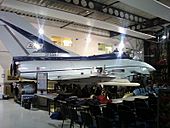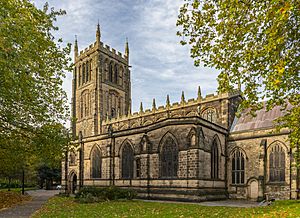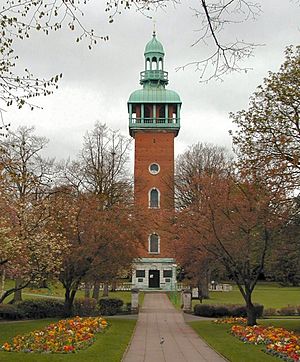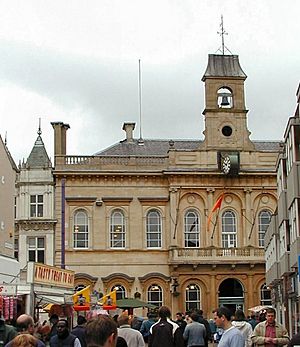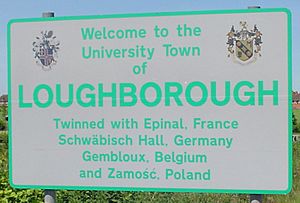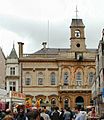Loughborough facts for kids
Quick facts for kids Loughborough |
|
|---|---|
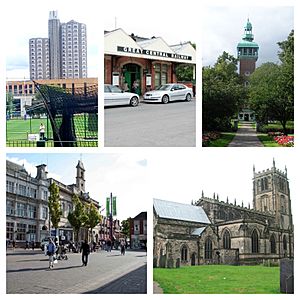 Clockwise from top left: Loughborough University; Central; Carillon; All Saints Church; Old Town Hall & town centre |
|
| Population | 64,884 (2021 Census Ward Profile) |
| OS grid reference | SK5319 |
| District |
|
| Shire county | |
| Region | |
| Country | England |
| Sovereign state | United Kingdom |
| Post town | LOUGHBOROUGH |
| Postcode district | LE11 |
| Dialling code | 01509 |
| Police | Leicestershire |
| Fire | Leicestershire |
| Ambulance | East Midlands |
| EU Parliament | East Midlands |
| UK Parliament |
|
Loughborough (![]() i/ˈlʌfbərə/ luf-BƏ-rə) is a busy market town in Leicestershire, England. It's the main town in the Charnwood area. In 2021, about 64,884 people lived here.
i/ˈlʌfbərə/ luf-BƏ-rə) is a busy market town in Leicestershire, England. It's the main town in the Charnwood area. In 2021, about 64,884 people lived here.
Loughborough is the second biggest town in Leicestershire, after Leicester. It's close to the border with Nottinghamshire. It's also about the same distance from Leicester, Nottingham, Derby, and the East Midlands Airport. Loughborough is famous for being home to the world's largest bell foundry, John Taylor Bellfounders. This company made the huge Great Paul bell for St Paul's Cathedral in London. They also made bells for the Carillon War Memorial, which is a well-known landmark in Queens Park.
Contents
History of Loughborough
Loughborough's Early Days
The first time Loughborough was mentioned was in a very old book called the Domesday Book in 1086. Back then, it was called Lucteburne. Later, it was known as Lucteburga and Luchteburc. Its name comes from Old English and means "Luhhede's fortified place."
A school called Loughborough Grammar School was started in 1495. This happened because a rich wool merchant named Thomas Burton left money in his will for it.
The Industrial Revolution in Loughborough
In the early 1800s, Loughborough began to change with new industries. An inventor named John Heathcoat created a special machine in 1809. This machine could make lace-like fabric.
Heathcoat moved his business near Loughborough, to a village called Hathern. But in 1816, his factory was attacked by a group called the Luddites. They destroyed many machines. After this, Heathcoat moved his business away.
In 1888, Loughborough was given a special permission to elect its own mayor and council. The town grew very quickly after that. Its population jumped from 11,000 to 25,000 in just ten years.
Many factories opened, including John Taylor & Co for making bells. The Falcon works made steam engines and then cars. It was later taken over by Brush Electrical Machines. In 1897, Herbert Morris started a factory that became famous for making cranes.
The town also invested in public services. They built a new sewage system in 1895, a waterworks in 1899, and a power station in 1899.
Loughborough and Tourism
Loughborough was part of a big moment in tourism history. In 1841, it was the destination for the very first package tour. This trip was organized by Thomas Cook for a group from Leicester who supported the Temperance movement.
Modern Loughborough
As Loughborough grew in the 20th century, new areas were built. Thorpe Acre was a small village until the mid-1900s. After World War II, many new homes were built there for workers. Today, two of Loughborough's high schools, Charnwood College and De Lisle College, are located nearby.
Shelthorpe is another new area in the south of Loughborough. Building started there in 1929. It has many shops, including a large Tesco supermarket. Other new housing areas like Hazel Road, Fairmeadows Way, and Grange Park were built later.
In 2018, there was some discussion about new homes being built. Residents felt they had been promised public places like shops and a church. However, the local council approved the plans for more homes.
Loughborough has also hosted successful vegan markets. The Charnwood Borough Council planned more of these markets for 2023.
What's Loughborough Like?
In 2021, Loughborough's main urban area had 64,884 people. Most residents were White (76.2%). About 15.7% were Asian or Asian British.
When it comes to religion, 45.3% of people said they had no religion. About 39.5% were Christian. Other religions included Muslim (7%) and Hindu (6.1%).
Loughborough's Weather
Like most of the UK, Loughborough has a maritime climate. This means it has cool summers and mild winters. The closest weather station is in Sutton Bonington, about 5 miles north. The highest temperature recorded there was 36.0°C (96.8°F) on July 25, 2019.
Economy of Loughborough
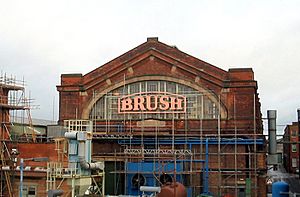
The main shopping area in Loughborough is Market Place and Market Street. These streets have some cool art deco buildings, like the one where the Odeon cinema is now. A big outdoor market happens every Thursday and Saturday in Market Place. There's also a farmers' market once a month. Markets have been held in Loughborough since at least 1221.
The Rushes shopping centre was built where the old bus station used to be. It has many well-known shops. This centre connects to the town centre through Churchgate, which has smaller, independent shops.
A big project called the Eastern Gateway was finished in 2013. It cost £20 million and improved the area around the railway station with new roads and homes.
The town centre became pedestrian-only in November 2014. This was done to help local businesses and reduce traffic pollution.
A new Cineworld cinema complex with restaurants opened in 2016. It was built on the site of the old General Hospital.
Getting Around Loughborough
Trains in Loughborough
Loughborough is the main train station. In 2012, the station was updated with longer platforms and better access. The local council also improved the area around it.
East Midlands Railway runs all the passenger trains. You can travel on two main routes:
- The Midland Main Line goes between London St Pancras, Nottingham, and Sheffield. You can also reach places like Derby and Leicester. Trains to London run every half hour.
- Trains also run between Leicester and Lincoln. Some of these trains continue to Grimsby or Cleethorpes.
In the past, Loughborough had three train lines. Now, only the Midland Main Line is still operating for regular passenger services. The Great Central Railway line closed, as did a branch line from Nuneaton.
Heritage Railway
Loughborough Central station reopened in March 1974. It is now part of the Great Central heritage railway. This railway is split into two parts, north and south of Loughborough. Loughborough Central is the end of the southern part. Trains run daily on this heritage line.
There are plans to connect the two halves of the railway. This gap is known as the Loughborough Gap. A new bridge has already been built over the Midland Main Line, the A60 road, and the Grand Union Canal. Work is still ongoing to restore another bridge.
| Station | Part of line | Serving area |
|---|---|---|
| Ruddington Transport Centre | Nottingham mainline | Ruddington |
| Rushcliffe Halt | Nottingham mainline | East Leake (British Gypsum) |
| Loughborough Central | Leicester mainline | Loughborough |
| Quorn & Woodhouse | Leicester mainline | Quorn, Woodhouse |
| Rothley | Leicester mainline | Rothley |
| Nunckley Hill | Mountsorrel branchline | Mountsorrel |
| Mountsorrel Halt | Mountsorrel branchline | Mountsorrel |
| Belgrave & Birstall (Leicester North) | Leicester mainline | Birstall |
Brush Traction, a company that makes train engines, is also in Loughborough. It's right next to the Midland railway station.
Roads in Loughborough
Loughborough is where three main roads meet. Two of these roads start in the town:
- The A6 road starts in Luton and goes north through Leicester and Derby.
- The A60 road starts in Loughborough and goes north to Nottingham and Mansfield.
- The A512 road starts in Loughborough and goes west towards the M1 motorway.
The A6004 road goes around the west and north of Loughborough, ending near the train station.
The M1 is a big highway that passes close to Loughborough. You can get to the town from Junction 23 or Junction 24.
Buses in Loughborough
Several bus companies run services in and around Loughborough. These include Arriva Midlands East, Kinchbus, and Centrebus.
Buses leave from stops on different streets in the town centre. The old bus station was removed around 2001 to make way for The Rushes shopping centre.
Waterways in Loughborough
The River Soar flows east of Loughborough. Boats can travel north towards the River Trent using the Loughborough Navigation, which ends at Loughborough Wharf. The Leicester Navigation connects to this, allowing boats to travel south. Both are part of the Grand Union Canal.
The old Charnwood Forest Canal used to connect Nanpantan (west of Loughborough) to Thringstone. Goods were brought into town by a horse-drawn wagonway.
Learning in Loughborough
Schools
Colleges and University
Loughborough University
Loughborough University is a very well-known university. It's often ranked as one of the top universities in the UK. For example, in 2006, it was ranked 6th by The Times.
The university has the biggest sports scholarship program in the UK. More than 250 international athletes study and train there. In 2008, it was named Sunday Times University of the Year.
Loughborough College
Loughborough College is the second largest education place in Loughborough, after the university. It offers courses for further education and job skills. It started in 1909 and has over 12,000 students.
RNIB College, Loughborough
RNIB College, Loughborough is a special college for people over 16 with different disabilities. It helps them get an education, find jobs, and live independently.
Youth Groups
Loughborough has many uniformed youth groups. These include Scouts and Girl Guides. There are also Girls' and Boys' Brigades. You can also find cadet forces like the Air Training Corps and Army Cadet Force. Other groups include St John Ambulance and a police cadet unit.
Fun Things to Do and See
Local Media
Loughborough has its own weekly newspaper, the Loughborough Echo. The town also gets news from Leicestershire's daily newspaper, the Leicester Mercury.
For TV, Loughborough is covered by BBC East Midlands and ITV Central. Local radio stations include BBC Radio Leicester and Carillon Radio.
Sports in Loughborough
Loughborough has a strong sports scene. It used to have a professional football club called Loughborough FC. Today, teams like Loughborough Dynamo and Loughborough University play football. There's also a women's team called Loughborough Foxes.
Cricket is also very popular. Many local clubs play, like Loughborough Town CC. The university is home to the ECB National Cricket Academy, where the England cricket team trains.
The town's rugby union club is Loughborough RFC. The university's rugby team, Loughborough Students RUFC, plays in a high league.
Other sports teams include the Loughborough Aces (American football) and Loughborough Lightning (netball). The town also has its own swimming club. The Aegon Pro-Series Loughborough tennis tournament is held here.
Many famous athletes train in Loughborough, including Olympic swimmer Adam Peaty.
Arts and Heritage
Loughborough has five museums. The biggest is the Charnwood Museum, which shows the history, nature, and industry of the area. In Queens Park, you can find the Carillon and War Memorial. It has a small museum about military items from the First and Second World Wars.
Near the beautiful medieval All Saints church, you can see the Old Rectory. This building dates back to 1288. Part of it has been restored and now holds a small museum run by the Loughborough Archaeological and Historical Society.
Loughborough has been home to John Taylor & Co, famous bell founders, for over a hundred years. Their Bellfoundry Museum tells the story of how bells have been made through history. The sound of the bell at the start of the AC/DC song "Hells Bells" was recorded using a bell similar to one in the Carillon war memorial.
There's also a museum at the old Great Central Railway station. It shows the history of the railway, which is now a preserved heritage line.
While Loughborough doesn't have a dedicated art gallery, you can find cool sculptures. One sculpture outside Charnwood Museum remembers the First World War. The Sockman is a bronze statue in the Market Place. It celebrates Loughborough's history with the hosiery (sock-making) industry.
The Loughborough Town Hall hosts concerts, shows, and a Christmas pantomime.
Charnwood Arts also organizes events, like the Picnic In the Park in Queens Park. Streets Alive is another event held around the same time.
The Great Central Railway is a heritage railway based at Loughborough Central Station. It's mostly run by volunteers. Trains run every weekend and on holidays.
Every November, a street fair takes over the town centre. It has rides, games, and food. Fairs have been held in Loughborough for hundreds of years. The first official fair was allowed by King Henry III in 1221.
The town has an Odeon cinema with six screens. It was built in 1914 and remodeled in 1936. There was also a Cineworld cinema that opened in 2016 but closed in 2024.
Famous People from Loughborough
Many interesting people were born or lived in Loughborough:
- John Cleveland (1613–1658), a poet.
- John Paget (1808–1892), a writer.
- John William Taylor (1827-1906), a famous bell founder.
- Arthur Donald Walsh (1916–1977), a chemist.
- Charles Denis Mee (born 1927), an engineer and author.
- Nicola Hughes, a stage actress.
- David Neilson, who plays Roy Cropper in Coronation Street.
- Viv Prince, a rock star from the 1960s.
- Dean Ward, who won a bronze medal in bobsleigh at the 1998 Winter Olympics.
- Danny Wallace, a comedian and TV presenter.
- Johnnie Johnson, a World War II fighter pilot.
- Ben Challenger, a high jumper.
- Mark Fisher, a cultural writer.
Many famous athletes also graduated from Loughborough University, including:
Footballers Liam Moore and Hamza Choudhury were born in Loughborough and have played in the Premier League.
Loughborough's Twin Towns
Loughborough is twinned with several towns in other countries. This means they have a special friendship and often visit each other:
- Épinal, France
- Gembloux, Belgium
- Schwäbisch Hall, Germany
- Zamość, Poland
Loughborough also has a friendship link with Bhavnagar, India.
Images for kids
-
Clockwise from top left: Loughborough University; Central; Carillon; All Saints Church; Old Town Hall & town centre
-
The Brush engineering works
See also
 In Spanish: Loughborough para niños
In Spanish: Loughborough para niños





